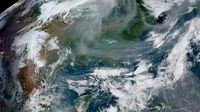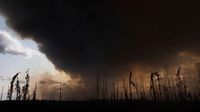As wildfire smoke from Canada continues to drift southward, millions across the northern and eastern United States are grappling with deteriorating air quality this week. From the Upper Midwest to the Northeast and Mid-Atlantic, hazy skies, smoky scents, and health advisories are becoming the new normal as more than 200 wildfires rage across Canadian provinces.
On June 3, 2025, residents in Minnesota, Wisconsin, and Iowa woke up to hazardous air conditions as thick smoke blanketed the region. The Twin Cities metro area, in particular, experienced some of the worst air quality in decades, with the air quality index (AQI) reaching a “very unhealthy” level of 288. According to FOX 9, this level is rare, having been recorded only a handful of times previously, and it poses immediate health risks even to healthy individuals. The smoky haze was so dense that visibility dropped below three miles in Minneapolis, and many could smell the unmistakable scent of burning wood lingering in the air.
Matt Taraldsen, a meteorologist with the Minnesota Pollution Control Agency (MPCA), explained that much of the state was under orange or red-level air quality alerts, signaling unhealthy conditions. He urged residents to limit outdoor activities and avoid exertion, especially those with asthma, chronic obstructive pulmonary disease (COPD), children, the elderly, and even pets. "If you can go outside and immediately see or smell smoke, that’s a pretty good indication that you’re likely in that red," Taraldsen noted. The MPCA issued an air quality alert effective through noon on June 4, as a cold front began to push the smoke eastward, bringing some relief but not fully clearing the skies.
Meanwhile, Ryan Lueck, an air quality forecaster for the MPCA, highlighted the severity of the situation in northwestern Minnesota, where a rare maroon warning—the agency's highest level—was issued due to thick smoke concentrations. This level, indicating hazardous air, has only been declared a few times in the past decade, with the last occurrence in 2021. Lueck warned that such severe alerts might become more frequent as the Canadian wildfire season peaks during the summer months, fueled by heat-dried vegetation. As of early June, British Columbia was battling 74 wildfires, Alberta 55, Saskatchewan 17, and Manitoba 26, according to the Canadian Interagency Forest Fire Centre.
Wisconsin faced similar challenges with smoke drifting from the northwest to the southeast throughout June 3. The Wisconsin Department of Natural Resources (DNR) issued air quality advisories, initially for the northwestern region, then extending statewide from noon on June 3 through noon on June 4. The DNR warned that health impacts could reach unhealthy levels, with short-term spikes to very unhealthy. They advised sensitive groups—including those with heart or lung diseases, older adults, and children—to shorten and reduce the intensity of outdoor activities. The DNR also recommended staying indoors, closing windows, avoiding indoor pollution sources like frying or vacuuming, and using high-efficiency air filters. For those needing to be outside for extended periods, wearing an N95 mask was advised. This marked the second such advisory in Wisconsin this year, with expectations that air quality issues will persist through the summer as wildfires continue.
In neighboring Minnesota, the National Weather Service anticipated rain showers and thunderstorms accompanying the cold front, which could help clean the air by bringing smoke particles closer to the ground and eventually dispersing them. However, meteorologist Melissa Dye cautioned that the air quality remained hazardous, especially for vulnerable populations. Symptoms such as itchy eyes, sore throats, and headaches were common, prompting officials to recommend limiting outdoor exposure and wearing well-fitting N95 masks. Motorists were also advised to reduce trips and recirculate air inside vehicles to minimize inhalation of polluted air.
Moving eastward, Maine braced for the arrival of Canadian wildfire smoke on June 4. Hundreds of fires were still burning across central Canada, with 91 out of control, according to the Canadian Forest Fire Centre. Upper-level winds shifted smoke southward over the Great Plains, then westward toward Maine. The state expected hazy skies by the evening of June 3, thickening on June 4. While most smoke would remain aloft, some could reach ground level, impacting air quality. Residents might notice a milky sky and strikingly red sunrises and sunsets, along with a faint smoky odor. Temperatures were expected to be slightly cooler due to the smoke. Although the smoke was forecasted to thin by June 5, ongoing fires suggested more smoky days ahead.
Further south, Delaware and much of the Northeastern U.S. anticipated moderate air quality impacts. The National Weather Service reported that smoke from Canadian wildfires had traveled as far south as Florida, creating a “very unhealthy” situation in parts of Minnesota and contributing to hazy conditions along the East Coast. Delaware’s Department of Natural Resources and Environmental Control predicted high-moderate ozone levels and low-moderate particulate matter (PM2.5) concentrations on June 3 and 4, leading to moderate AQI readings around 84 to 93. Despite the smoke, Delaware's air quality remained generally acceptable, with good AQI levels reported on June 3. However, the combination of sunshine, warm temperatures, and smoke recirculation could elevate pollutant levels throughout the week.
Experts emphasize that the wildfire smoke is not merely a temporary nuisance but poses significant health risks. A recent study from Mount Sinai Hospital in New York found that particulate matter from wildfire smoke can impact health for up to three months after exposure. Peter DeCarlo, an environmental health professor at Johns Hopkins University, explained that high concentrations of smoke particles can overwhelm the body’s defenses, leading to respiratory and cardiovascular issues.
As summer progresses, the persistence of Canadian wildfires and their smoke plume remains a looming concern. Officials across affected states urge vigilance, preparation, and adherence to health guidelines to mitigate the impact of this smoky season. Whether it’s by limiting outdoor exertion, staying indoors with filtered air, or wearing protective masks, residents are encouraged to take the necessary precautions to safeguard their health amid this smoky haze.



